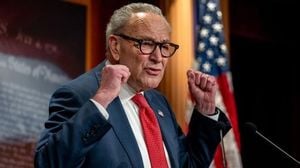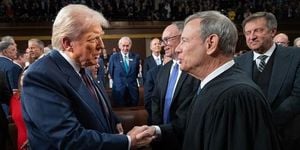The U.S. Supreme Court delivered a major ruling on Friday, September 26, 2025, siding with President Donald Trump and granting his administration the authority to withhold approximately $4 billion in foreign aid that had been authorized by Congress for the current fiscal year. The decision, reported by both CNN and BBC, marks a significant victory for Trump’s “America First” agenda and raises fundamental questions about the balance of power between the executive and legislative branches when it comes to government spending.
At the heart of the dispute was whether the president can block or rescind funds that Congress has already appropriated for programs that conflict with the administration’s policies. The $4 billion in question was earmarked for a broad array of initiatives, including United Nations peacekeeping operations, democracy-promotion efforts abroad, global health and HIV programs, micro-insurance support for small farmers in Colombia, climate resilience projects in Honduras, and assistance for victims of torture. According to CNN, the Trump administration argued that these programs were either wasteful or contrary to U.S. foreign policy priorities.
The legal battle began in February 2025, when a coalition of nonprofit organizations and aid groups filed a lawsuit challenging the administration’s attempt to freeze the funds. They argued that the cuts amounted to an “unconstitutional exercise of executive power” and would cause chaos in American foreign assistance efforts. Scott Roehm, director of global policy at the Center for Victims of Torture, one of the plaintiffs, told CNN, “Gutting that program punishes torture survivors; people suffering from the deep physical and psychological scars that torturers inflict. The administration is abandoning torture victims to serve a naked political agenda, nothing more.”
To justify the freeze, the administration employed a rarely used maneuver known as a “pocket rescission.” Under federal law, if the president notifies Congress of an intent to rescind approved funding, lawmakers have 45 days to act on the request. If Congress doesn’t approve the cut within that window, the funds must typically be spent. However, Trump’s team sent the notice within 45 days of the end of the fiscal year—September 30, 2025—effectively running out the clock and allowing the funding approvals to expire before any action could be taken, as detailed by BBC and CNN.
U.S. District Judge Amir Ali, who was nominated to the bench by former President Joe Biden, initially sided with the plaintiffs. In his September 3, 2025, ruling, Judge Ali declared that the executive branch “cannot simply choose not to comply with appropriations laws unless Congress formally changes them.” He wrote that Trump’s effort “usurps Congress’s exclusive authority to dictate whether the funds should be spent in the first place,” ordering the administration to release the money as Congress had directed.
The administration quickly appealed. The D.C. Circuit Court of Appeals upheld Judge Ali’s order in a 2-1 decision on September 5, 2025, but later revised its stance, allowing a narrower portion of the litigation to proceed. On September 9, 2025, the Supreme Court temporarily paused Judge Ali’s order, giving the justices time to consider the administration’s emergency request.
In its unsigned order, the Supreme Court stated that the Trump administration’s concern that the lower court’s order would affect its “conduct of foreign affairs” appeared to “outweigh the potential harm” faced by the nonprofit groups hoping to compete for the withheld funds. The Court emphasized, “This order should not be read as a final determination on the merits. The relief granted by the court today reflects our preliminary view, consistent with the standards for interim relief.”
The three liberal justices—Elena Kagan, Sonia Sotomayor, and Ketanji Brown Jackson—dissented forcefully. Justice Kagan, writing for the dissenters, argued, “That is just the price of living under a Constitution that gives Congress the power to make spending decisions through the enactment of appropriations laws. If those laws require obligation of the money, and if Congress has not by rescission or other action relieved the executive of that duty, then the executive must comply. It cannot be heard to complain, as it does here, that the laws clash with the president’s differing view of ‘American values’ and ‘American interests.’”
Kagan also criticized the majority for deciding such a consequential matter on the Court’s emergency docket, which has become increasingly common in 2025. “We have had to consider this application on a short fuse – less than three weeks,” she wrote. “We have done so with scant briefing, no oral argument, and no opportunity to deliberate in conference. In a few weeks’ time, when the court starts its new term, we will decide cases of far less import with far more process and reflection.”
For the Trump administration, the Supreme Court’s decision was a clear affirmation of executive authority. U.S. Solicitor General D. John Sauer argued before the Court, “The president can hardly speak with one voice in foreign affairs or in dealings with Congress when the district court is forcing the executive branch to advocate against its own objectives.” The administration also told the justices that it intended to spend $6.5 billion of the foreign aid at issue by September 30, but wanted to withhold the remaining $4 billion.
According to BBC, the Supreme Court’s latest ruling fits a broader pattern this year, as the Court’s 6-3 conservative majority has repeatedly sided with Trump’s administration on contentious policy issues, often through emergency orders with limited explanation. Since Trump’s return to the White House in January 2025, the justices have backed his team in nearly every case they have reviewed. However, there have been exceptions: in March 2025, the Court ruled 5-4 against allowing the administration to withhold $2 billion in payments owed to aid organizations for work already completed under government contracts.
The broader implications of the ruling are substantial. By upholding the administration’s use of the “pocket rescission,” the Court may have provided the president with a roadmap to cancel more congressionally approved spending in the future—potentially shifting the balance of power between Congress and the White House when it comes to the federal purse. The case has also become tightly intertwined with budget negotiations on Capitol Hill, as Congress faces a looming deadline to fund the government or risk a shutdown.
With the government’s fiscal year set to end on September 30, 2025, and roughly $11 billion in foreign aid due to expire, the stakes remain high for both lawmakers and the millions of people around the globe who rely on U.S. assistance. The Supreme Court’s decision has left many aid organizations and their beneficiaries in limbo, while also sparking a renewed debate about the constitutional separation of powers and the future of American foreign policy.
As the dust settles, the ruling stands as a testament to the enduring tensions between the branches of government—and the real-world consequences that flow from their decisions.





